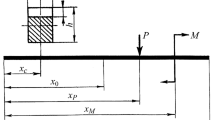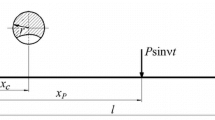The paper presents some findings of analytical and numerical investigations aimed at determining the influence of inelastic resistance on vibrodiagnostic parameters indicating the presence of damage, such as a breathing crack, in an elastic body under the main and subharmonic resonances.









Similar content being viewed by others
References
S. L. Tsyfansky and V. I. Beresnevich, “Detection of fatigue cracks in flexible geometrically non-linear bars by vibration monitoring,” J. Sound Vibration, 213, No. 1, 159–168 (1998).
S. L. Tsyfansky and V. I. Beresnevich, “Non-linear vibration method for detection of fatigue cracks in aircraft wings,” J. Sound Vibration, 236, No. 1, 49–60 (2000).
J. C. Ji and C. H. Hansen, “On the approximate solution of a piecewise nonlinear oscillator under super-harmonic resonance,” J. Sound Vibration, 283, No. 1-2, 467–474 (2005).
A. P. Bovsunovskii, C. Surace, and O. A. Bovsunovskii, “The effect of damping and force application point on the non-linear dynamic behavior of a cracked beam at sub- and superresonance vibrations,” Strength Mater., 38, No. 5, 492–497 (2006).
Z. K. Peng, Z. Q. Lang, and S. A. Billings, “Crack detection using nonlinear output frequency response functions,” J. Sound Vibration, 301, No. 3-5, 777–788 (2007).
Animesh Chatterjee, “Structural damage assessment in a cantilever beam with a breathing crack using higher order frequency response functions,” J. Sound Vibration, 329, No. 16, 3325–3334 (2010).
A. P. Bovsunovskii and O. A. Bovsunovskii, “Application of nonlinear resonances for the diagnostics of closing cracks in rodlike elements,” Strength Mater., 42, No. 3, 331–343 (2010).
Ugo Andreaus and Paolo Baragatti, “Cracked beam identification by numerically analyzing the nonlinear behaviour of the harmonically forced response,” J. Sound Vibration, 330, 721–742 (2011).
V. V. Matveev and O. E. Boginich, “Approximate determination of vibrodiagnostic parameter of nonlinearity for an elastic body due to the presence of a breathing crack at a subharmonic resonance,” Strength Mater., 44, No. 3, 250–258 (2012).
G. S. Pisarenko, Energy Dissipation in Mechanical Vibration [in Russian], AN UkrSSR, Kiev (1962).
A. P. Bovsunovsky, “Shape of the mechanical hysteresis loop for metallic materials under harmonic stresses below the endurance limit. Part II. Experimental procedure and results,” Strength Mater., 29, No. 3, 298–307 (1997).
V. V. Matveev, Damping of Vibration of Deformable Bodies [in Russian], Naukova Dumka, Kiev (1985).
V. V. Matveev, A. P. Yakovlev, and I. M. Vasinyuk, “On determining the damping rate of vibrations of nonlinear systems of the hysteresis type from the resonance curve,” Soviet Appl. Mech., 6, No. 1, 81–84 (1970).
V. V. Matveev and A. P. Yakovlev, “Determination of the decrement of the vibrations of a nonlinear system of the hysteresis type from the width of the resonance peak of the amplitude–frequency characteristic,” Strength Mater., 8, No. 9, 1090–1092 (1976).
V. V. Matveev, O. E. Boginich, and A. P. Yakovlev, “Approximate analytical method for determining the vibration-diagnostic parameter indicating the presence of a crack in a distributed-parameter elastic system at super- and subharmonic resonances,” Strength Mater., 42, No. 5, 528–543 (2010).
V. V. Matveev, O. E. Boginich, and A. P. Yakovlev, “Approximate methods for and results of determination of vibrodiagnostic parameters indicating the presence of a crack in rod-like elements at super- and subharmonic resonances,” in: V. T. Troshchenko (Ed.), Strength of Materials and Structural Elements [in Russian], Proc. Int. Sci. Conf. “Strength of Materials and Structural Elements” (Kiev, Sept. 28–30, 2010), Pisarenko Institute of Problems of Strength of the National Academy of Sciences of Ukraine, Kiev (2011), pp. 59–77.
A. E. Mudrov, Numerical Methods for PC Software in Basic, Fortran, and Pascal [in Russian], MP Rasko, Tomsk (1991).
Author information
Authors and Affiliations
Additional information
Translated from Problemy Prochnosti, No. 1, pp. 5 – 24, January – February, 2014.
Rights and permissions
About this article
Cite this article
Matveev, V.V., Boginich, O.E. The Influence of Inelastic Resistance on Vibrations of an Elastic Body with a Closing Crack under the Main and Subharmonic Resonances. Strength Mater 46, 1–17 (2014). https://doi.org/10.1007/s11223-014-9511-4
Received:
Published:
Issue Date:
DOI: https://doi.org/10.1007/s11223-014-9511-4




